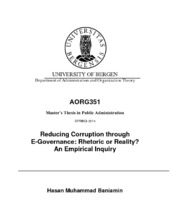| dc.description.abstract | Corruption has been considered as one of the most prevalent and persistent challenges in enhancing economic growth and improving the quality of life of the citizens across the globe. Amidst the negative consequences of corruption and the limited successes in controlling corruption in many countries, the potentials to combat corruption by using E-governance is gaining popularity in the public policy discourse. This increased enthusiasm demands further inquiry to understand the degree of effectiveness. The present study is an attempt to explore this potential of E-governance through the use of global level data as well as micro level cases. The global data are collected from the two databases: Corruption Perception Index (CPI) by Transparency International and Online Service Index (OSI) by United Nation; while the micro level cases are taken from a country (Bangladesh) where the intensity of corruption is comparatively higher and the system of E-governance is emerging. The findings of the current research reaffirm the potential of E-governance as a means to curb corruption with some observations and conditions. The findings based on the state level data indicate that E-governance can explain most of the variations of the level of corruption in the different countries i.e. support the main argument of the study that E-governance may have positive impacts in reducing corruption. The findings seem to be robust and more consistent in the developing countries though some of the developed countries, particularly the OECD countries show inconsistent trends. These findings are also consistent with other studies, e.g. the study of Andrew (2009) who conducted the research by WB's Control of Corruption Index'. The patterns of corruption may provide an explanation of the variations of the effectiveness of E-governance in the different countries. It may be more effective on certain types of corruption (like petty corruption done by street level bureaucrats) by changing the service delivery channels and by eliminating the provisions for the direct human interaction as it can increase the bargaining power of the respective officials. In contrast, E-governance may not be effective for the policy level or the strategic corruption as E-governance itself is dependent on those policy inputs; like the tailor-made specifications to favor someone in the bidding. E-governance is just a tool to select the best bidder based on those policy decisions and if the policies are flawed or biased then it may play a limited role to curb corruption. From the micro level cases, it appears that the mere introduction of E-governance is not sufficient to control corruption, its nature and maturity levels are also important. As part of the natural experimental design, the study includes different levels of E-governance to understand the dynamics between E-governance and corruption. The dynamics that emerged from the different levels of E-governance provide some understandings about the nature of E-governance which can have greater impacts on corruption and some insights on explaining the limited successes of the different E-governance initiatives/projects. From the sample cases, it appears that E-governance may have larger impacts when it can affect power relations in an organization. This power can be affected when E-governance can provide an alternative service delivery channel through the electronic platform. In such a case,... | en_US |
